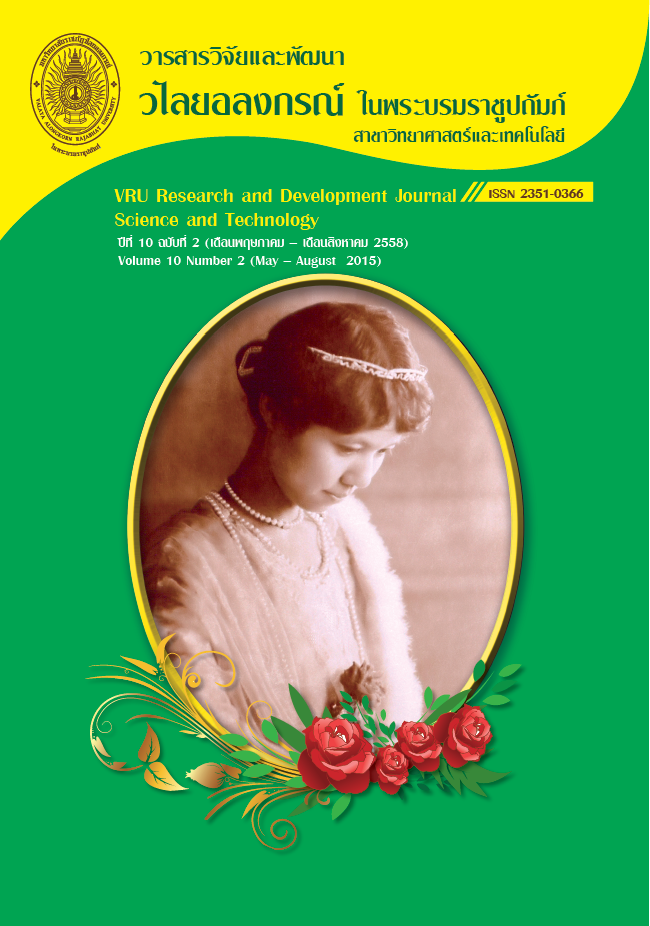การศึกษาการทนต่อยาปฏิชีวนะและยาฆ่าแมลงของ Sinorhizobium meliloti
Main Article Content
บทคัดย่อ
Multidrug resistance efflux pumps (MDR) เป็นกลไกลที่สำคัญของแบคทีเรียซึ่งเกี่ยวข้องกับการขับสารที่เป็นพิษต่อเซลล์ออกจากเซลล์ทำให้แบคทีเรียนั้นๆ สามารถอยู่รอดในสภาวะที่ไม่เหมาะสมได้ สำหรับ Sinorhizobium meliloti ซึ่งเป็นแบคทีเรียที่พบได้ในดินและมีโอกาสที่จะสัมผัสกับสารพิษทั้งจากการเกษตรกรรมและอุตสาหกรรม MDR ก็เป็นกลไกหนึ่งซึ่งเกี่ยวข้องกับการป้องกันเซลล์จากสารที่เป็นพิษ ในการทดลองนี้ทำจะการทดสอบหาค่า minimal inhibition concentration (MIC) โดยทำการทดสอบกับ Sinorhizobium meliloti สายพันธุ์ดั้งเดิม และสายพันธุ์ที่ทำให้เกิดการเสียสภาพของยีน Smc03167 และ Smc03168 ซึ่งเป็นยีนที่พบว่ามีความเกี่ยวข้องกับ MDR ชนิดหนึ่งของ Sinorhizobium meliloti ซึ่งในการทดลองจะใช้ยาปฏิชีวนะทั้งหมด 6 ชนิดคือ tetracycline, chloramphenicol, nalidixic acid, neomycin, kanamycin และ carbonyl cyanide 3-chlorophenylhydrazone (CCCP) และใช้ยาฆ่าแมลงทั้งหมด 3 ชนิดคือ bentazol, chlorpyrifos และ pentachlorophenol ผลการทดลองพบว่า ค่า MIC มีความแตกต่างกันระหว่างสายพันธุ์ดั้งเดิมและสายพันธุ์ที่ทำให้เกิดการเสียสภาพของยีนเมื่อทำการทดสอบกับยาฆ่าแมลง แต่ไม่พบความแตกต่างระหว่างสายพันธุ์ดั้งเดิมและสายพันธุ์ที่ทำให้เกิดการเสียสภาพของยีนเมื่อทำการทดสอบกับยาปฏิชีวนะ
Article Details
ลิขสิทธิ์บทความวิจัยที่ได้รับการตีพิมพ์เผยแพร่ในวารสารวิจัยและพัฒนา วไลยอลงกรณ์ ในพระบรมราชูปถัมภ์ ถือเป็นกรรมสิทธิ์ของสถาบันวิจัยและพัฒนา มหาวิทยาลัยราชภัฏวไลยอลงกรณ์ ในพระบรมราชูปถัมภ์ ห้ามนำข้อความทั้งหมดหรือบางส่วนไปพิมพ์ซ้ำ เว้นแต่จะได้รับอนุญาตจากมหาวิทยาลัยเป็นลายลักษณ์อักษร
ความรับผิดชอบ เนื้อหาต้นฉบับที่ปรากฏในวารสารวิจัยและพัฒนา วไลยอลงกรณ์ ในพระบรมราชูปถัมภ์ เป็นความรับผิดชอบของผู้นิพนธ์บทความหรือผู้เขียนเอง ทั้งนี้ไม่รวมความผิดพลาดอันเกิดจากเทคนิคการพิมพ์
References
หนึ่ง เตียอำรุง และ นันทกรบุญเกิด. (2539). ความสัมพันธุ์ระหว่างไรโซเบียมกับพืชตะกูลถั่วในเชิงพันธุกรรมระดับโมโลกุล. วารสารเทคโนโลยีสุรนารี. 3: 15-20.
Alekshun M. N. and S. B. Levy. (2007). Molecular mechanisms of antibacterial multidrug resistance. Cell. 128: 1037-1050
Li X. Z. and Nikaido H. (2009). Efflux-mediated drug resistance in bacteria: an update. Drugs. 69: 1555-1623.
Borges-Walmsley et al. (2003). Structure and function of efflux pumps that confer resistance to drugs. Biochem. J. 376: 313-338.
Piddock J. V. (2006). Multidrug-resistance efflux pumps-not just for resistance. Microbiology. 4: 629-636.
Poole K., (2007). Efflux pumps as antimicrobial resistance mechanisms. Ann. Med. 39: 162-176
Konstantinidis KT. And Tiedje JM. (2004). Trends between gene content and genome size in prokaryotic species with larger genomes. P Natl Acad Sci USA. 101: 3160-3165
Martinez J. L. et al. (2009). Functional role of bacterial multidrug efflux pumps in microbial natural ecosystems. FEMS Microbiol. Rev. 33: 430-449.
Shima Eda. et al. (2011). Involvement of the SmeAB multidrug efflux pump in resistance to plant antimicrobials and contribution to nodulation competitiveness in Sinorhizobium meliloti. Applied and Environmental Microbiology. 77: 2855-2862.
Jingjing S. et al. (2014). Bacterail multidrug efflux pumps: Mechanisms, physiology and pharmacological exploitations. Biochemical and Biophysical Research Communications. 453: 254-267.
Lomovskaya 0. and K. Lewis. (1992). emr, an Escherichia coli locus for Multidrug Resistance. Proc. Natl. Acad. Sci. U.S.A. 89:8938-8942.
Furukawa H. et al. (1993). Thiolactomycin Resistance in Escherichia coli Is Associated with the Multidrug Resistance Efflux Pump Encoded by emrAB. J. Bacterid. 175:3723- 3729.
Li X. Z. et al. (1994). Role of efflux pump(s) in intrinsic resistance of Pseudomonas aeruginosa: resistance to tetracycline, chloramphenicol, and norfloxacin. Antimicrob. Agents Chemother. 38: 1732-1741.
Poole K. et al. (1993). Multiple antibiotic resistance in Pseudomonas aeruginosa: evidence for involvement of an efflux operon. J. Bacteriol. 175: 7363-7372.
Eaves D. J. et al. (2004). Expression of arcB, arcF, arcD, mprA and soxS in Samonella enterica serovar Typhimurium: role in multiple antibiotic resistance. Antimicrob. Agents. Chemother. 48: 1145-1150.
Pumbwe et al. (2004). Expression of the efflux pump genes cmeB, cmeF and the porin gene porA in multiply antibiotic resistant Campylobacter spp. J. Antimicrob. Chemother. 54: 341-347.
Ramon G. and Esperanza M. (2000). Multiresistance Genes of Rhizobium etli CFN42. Mol. Plant. Microbe Interact. 13:572-577.
Palumbo J. D. et al. (1998). An isoflavonoid inducible efflux pump in Agrobacterium tumefarciens is involvein competitive colonization of roots. J. Bacteriol. 180: 3107-3113.
Jocelyn et al. (2007). Transcriptome analysis reveals that Multidrug Efflux Genes are unregulated to protect Pseudomonas aeruginos from pentachlorophenol stress. Applied and environmental microbiology. 73: 4550-4558.
Wirongrong w. et al. (2010). ChrR is a Chlopyrifos-responsive transcription regulator in Sinorhizobium meliloti. J Mol Microbiology Biotechnol. 18:141-147.

